| The Panagia Kroustallenia
monastery lies on a 15 m high hill north of Agios Konstantinos. The
monastery is dedicated to The Passing Away of the Virgin Mary, celebrated
on August 15th. |
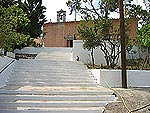
|
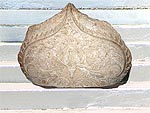 |
It is not known with certainty
when the monastery was founded, but a relief, once built-in above the door,
mentions the year 1241. The church was then dedicated to St John the
Baptist. |
| Through the beautiful
entrance-gate, you enter the court, where new monk's cells and guestrooms
for laymen are being built at the moment. |
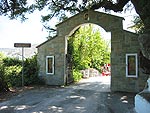
|
| To the left are the monk's
cells and other administrative rooms.
|
|
| At the end of the building is
an oak tree, solidly planted in a large rock with the local name of
Agiocharako (Holy Rock). The tree has no less than 18 trunks, each
symbolizing one of the villages of the Lassithi plateau: Tzermiado,
Marmaketo, Mesa Lassithi, Mesa Lassithaki, Exo Potami, Mesa Potami, Agios
Konstantinos, Agios Georgios, Koudoumalia, Avrakonte, Kaminaki, Magoulas,
Psychro, Plati, Agios Charalambos, Kato Metochi, Pinakiano and Lagou.
|
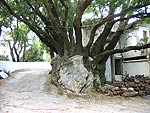
|
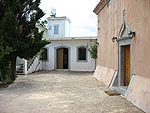 |
To the right, a long flight of
steps leads up to the church and the visitors' reception room. |
|
|
|
|
|
| In 1272 the Cretan Resistance
assembled for a mass in the monastery in order to pray for strength in the
struggle against the Venetian rule. Less than 20 years would however pass,
until the Venetians prohibited any stay on the Lassithi plateau and
destroyed all existing buildings.
|
| In the middle of the 16th
century, quite a few refugees from Peloponnese settled on Lassithi after
the Turkish capture of Nafplion. Among them was the nun, Palladia, who
rebuilt the convent.
|
| Shortly after the rebuilding, a
woman from a nearby village dreamed that Virgin Mary came to her and
ordered her to go to a cave near the convent. The woman went to the cave
on the following day and found a Panagia icon, which she immediately
brought to the convent. From that icon, painted on crystal, the monastery
got its name. Unfortunately, the icon disappeared in 1890. |
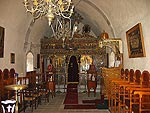
|
|
|
|
|
|
| In the Turkish period the
convent had become a monastery. It supported actively the resistance
against the Turks, which it had to suffer for, so it was looted and burned
down several times.
|
| In 1740, a son of the Rovithis family was to be baptised in the church of
the monastery. Before that the baptismal font had, however, been destroyed
by the janizaries, so the child was baptised in a big casserole (kazani).
With the Cretans' sense of humour, the boy immediately got the byname
Kazanis. He became the grandfather of the well-known resister Manolis
Kazanis. |
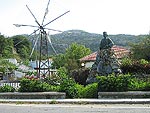
|
|
|
|
|
|
| The monastery was destroyed
again in 1823 during Hassan Pasha's attack on Lassithi, and the French
explorer A. Fabreguettes, who visited the monastery in 1834, tells that
the monastery had not yet overcome the damages. It was not reopened until
1862.
|
| Only five years after the
reopening, the monastery was destroyed once again, when the Turks with the
help of the Egyptian army led by Ismail Ferik Pasha, captured the plateau.
Ismail Pasha was originally the
son
of a Greek priest from
the village of Psychro, but was in 1823 kidnapped and
taken to Cairo, where he was brought up as a Muslim. He had great gifts as
a leader and was appointed minister of war in Egypt.
|
| But fate decided that he
several years later would return and destroy his own native town and the
Kroustallenia monastery. The story becomes even more grotesque as the
Cretan Resistance was partly funded by his brother Antonios, who had
accumulated a large fortune in the free Greece. After the battle, Ismail
was killed by the Turks who feared that he might remember his childhood
years and perhaps was secretly Christian (Crypto Christian).
|
| After this the monastery was
allowed to work quietly until World War II, where Greek forces took refuge
in the monastery. The monastery superintendent Ermolaos Kasapakis also
took an active part in the resistance movement and was arrested twice. |
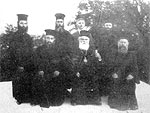
|
|
|
|
|
|
| In February 1943 the
Italian occupying forces turned the monastery into an internment camp for
political captives. During this period great damage was done to the
buildings, as the occupiers walled up all the windows and doors except for
one, in order to be in control of the captives. They also cut down all the
old trees around the monastery, smashed all the storage pitchers and tore
off the roof of the monk's cells in order to use the materials for the
construction of observation posts at Seli Ambelou. The monks first fled to
the Vidiani monastery, but a few months later they had to flee from there
too. Not until after the Italian surrender in 1944, the monks were able to
return to the monastery.
|
| In addition to its
participation in the various Cretan rebellions, the monastery had as early
as the Turkish period founded a basic school for the children of the
Lassithi plateau. Until 1870 it was the only school of the plateau. The
pupils were taught reading and writing plus the practical agricultural
subjects, for which reason they had a small piece of land of their own to
look after.
|
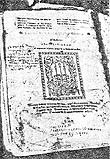
|
| The available ecclesiastical
books were used as teaching materials, and every time the pupils had
finished a book, they were moved up to the next class.
|
| In 1912 the monastery
school was moved to the village
of
Mesa
Lassithi,
but
most
of
the
parents
preferred
the
school
to
be
within
the
framework
of
the
monastery,
so
it
was
moved
back
in
1914.
The
school
was
closed
down
in
1925
when
new
schools
were
established
in
Marmaketo, Agios Konstantinos and Mesa Lassithi.
|
| The monastery also took care of
many of the religious ceremonies in the area, for example, until World War
II, the tradition of blessing the soil in order
to
achieve a large harvest. The ceremony took place in spring and spread over three days.
|
| In the morning of the
first day, they celebrated mass in the
Kroustallenia
monastery,
after
which
the
monks
and
the
highest
priest
of
Lassithi
took
the
icons,
the
"exapterygo"
(metal
plates
with
depictions
of
the
seraphs),
the
cross
and
banners
from
the
church
and
walked
in
procession
to
Agios
Konstantinos.
Here
another
mass
was
celebrated,
and
then
they
continued
to
Mesa
Lassithi
and
Marmaketo,
ending
with
an
evening
mass
in
Tzermiado. |
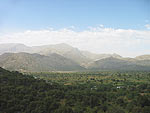
|
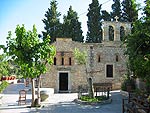 |
The following morning began
with yet another mass in Tzermiado after which they continued to Lagou and
Pinakiano. Believers and nuns from the Panagia Kera convent north of the
plateau now joined the procession, bringing the miracle-creating Panagia
icon. From here they all continued to the Vidiani monastery, Kato Metochi,
Agios Charalambos, Plati, and Psychro where evening mass was celebrated. |
| Panagia Kera Convent
|
|
|
|
| The third day began again with
a morning mass before continuing to Magoulas, Kaminaki, Avrakonte, Agios
Georgios, and to St John the Baptist's church on the plateau, where the
twentieth and last mass was celebrated. Finally the water in the cistern
was blessed, so that all those who participated in the procession might
have their own part of the blessed water. The ceremony had now finished,
and the participants returned to their respective villages with their local priest. |
|
|
|
|


